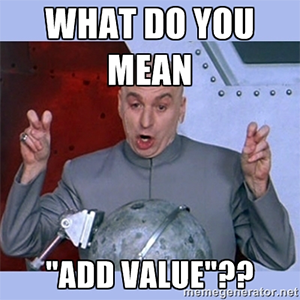There are more and more salespeople who have adopted a value-added approach to sales as a means to differentiate themselves from competitors, but few of them put a real dollar value on the value-added benefits and services they provide.
Don’t forget, all benefits are claims, which means they are largely intangible and often difficult for your customer to grasp. When presenting value-added benefits, the proof of their value is even more intangible. The customer is usually not seeking it or paying for it, and may not even realize that they exist. However, identifying value-added benefits often requires a number of resources or services. A salesperson must make the value-added benefit as concrete and tangible as possible, and then present it effectively, in a way that decision-makers both understand and appreciate it.
HOW TO QUANTIFY VALUE-ADDED BENEFITS
With a bit of creativity and some number-crunching, a salesperson should be able to quantify most value-added benefits. Also, while all value-added benefits should be presented and reinforced – including benefits that are difficult to quantify, like relationships and trust – quantified benefits are more visible and leave a positive and lasting impression with the customer. Here are some pointers on quantifying these benefits.
• Start with the value of the benefit. If the benefit cannot be measured in specific terms, try to compute the cost of the service that provides the value-added benefit. For example, your company provides its customers with a customer portal (value-added service), and while the entire transportation department at the customer location can now easily access specific shipment information in one location (invoices, POD’s, other shipment related paperwork), instead of making multiple calls to carriers to check on the status of a particular shipment, there’s no way of measuring how much this has contributed to their bottom line. However, with research you can determine that the portal, based on the number of shipments and confirmation calls required prior to offering that service, will save the customer four hours per week.
• Measure value in bottom-line dollars. Think in terms of profit increases, reduced overhead, increased productivity, and so on. As an example, it’s more effective to say, “If you follow my inventory suggestion, you’ll be able to generate a $10,000 annual return on the space saved,” than it is to use the less effective statement, “You’ll be able to find a more productive use for the 3,000 square feet saved by the inventory reduction.”
• Link value-added services or benefits to make a more sizable benefit. Keep this in mind when quantifying the total value-added contribution. Measure values individually but link them to increase the total amount of the benefits accruing to the customer.
• Project the values over a longer period of time. Obviously, if a value-added benefit has a life cycle of six months or isn’t enhanced over time, you’re limited. However, if you provide ongoing benefit to the customer, you have earned the right to value it over a longer period of time. Many salespeople project value over a period of one to three years. Use common sense to choose a time period appropriate to the specific value-added benefit. For example, it’s more effective to say, “We estimate that our just-in-time service will allow you to save $8,000 a year in inventory costs,” than it is to say, “Our JIT service might help you save up to $150 per week.”
SELL VALUE ON EVERY CALL
If you’ve provided a significant value-added service to a customer, you should capitalize on it immediately, which may be on your next sales call.
Value-added benefits are special and should be presented on their own stage. Do not merge them with product benefits or present them casually. Set the stage by using a transition, such as, “In addition to our normal service, we are pleased that we could allocate staff specifically to manage your freight needs for your eight distribution centers during the quarter. I estimate that this extra service will save you over $6,000 in actual costs and, in addition, adds value by ensuring each shipment gets individual attention and receives the best price and service.”
Always document your data to reinforce the specific and measurable values. Either show the customer your figures in a clear presentation prepared in advance, or dramatically recreate your estimates and calculations on the spot.
When you’re presenting to a new decision-maker or new account, be prepared to cite value-added success stories that you have generated for other accounts. Treat these experiences as “case studies,” and use them to differentiate your offering and improve your presentation.
Value-added summary
1. All value-added benefits provide value to the customer, and most values can be quantified.
2. When quantifying value, the ideal method is to measure the benefit. If this can’t be done, quantify the cost of providing the service (what it costs your company to provide this benefit).
3. If more than one value-added benefit, service, or resource is involved, link them by adding or multiplying as needed.
4. To maximize the value, project the benefits over the long term.
Value AddedSales
0 comments

